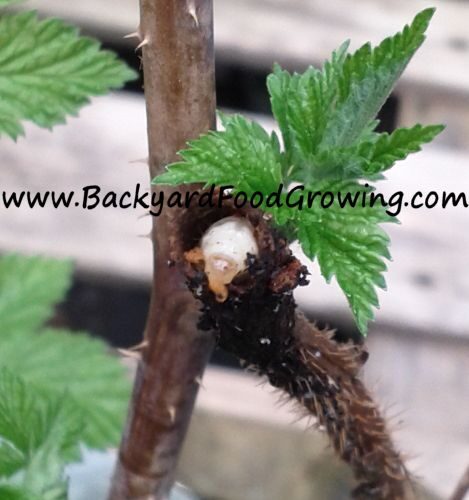The Raspberry Crown Borer (Pennisetia marginata) and its larva are common pests of the raspberry plant. They are common throughout most of North America and are very common here on the west coast of BC and Washington.
They are also known as Blackberry Clearwing Borer, as they can affect the closely related blackberry plant as well. Wild blackberries are a carrier of this pest and they will spread to nearby gardens with raspberries if they are close enough. They will infect your raspberries easily.
Their life cycle is nearly invisible and you don’t notice they are there until your plant is badly infested. The larva bore into the crown of the plant and chew tunnels in to it over the winter.
Identify the Signs
The canes with healthy green growth will just tip over as if they were broken or cut and then just lie on the ground or across the top of the pot.
Canes that have done this are easy to tug and pull off. Quite often you’ll actually be able to see the borer right there in the end of the stalk. He hides in the completely hollowed out floricane that he calls home.
The raspberry plants that have infestations like this will, slowly over time fail to produce new primocanes, and without new primocanes to replace the older floricanes, the entire plant will eventually die after a few years of struggling.
Identification
In order to determine if you have a crown borer problem, simply dig up a crown and look for the larva. You may also spot a ‘sawdust’ like material, which is actually the shredded remains of your raspberry crown.
Appearance
At maturity the raspberry crown borer larva can reach 2.5 cm long. It is a whitish-yellowish colour with a darker brown head. They are unlike other worm-like larva in that they have clearly visible legs. The cane in the image below is about the size and diameter of a chopstick, very small.
You can easily see the crown borer in the hollowed out cane below.
The adult raspberry crown borer bears no resemblance at all to it’s larval stage. It’s long and narrow with black and yellow stripes and wings.
It’s colour markings make it look like a yellow-jacket wasp, but it is actually a moth of the “Sesiidae” family. It has brownish clear wings and a total body length of 1″ and a wing span of up to 3 cm.
This family includes many other “borers” such as the peach borer, lilac borer, grape root borer, strawberry crown borer and more.
Life Cycle
Most of the time it is a two year cycle but in some cases the life cycle completes in just one year.
The winged adult lays its eggs in the summer on the on the leaves of the plant. The larva hatch and then make their way down the canes to the crown of the plant. Once there they bore into the crown where they spend the winter well protected. Sometimes they will bore into the larger roots as well.
The larva remain there for two years where they mature to adulthood while at the same time destroying your raspberry plant from the inside out. You wouldn’t even know that this is happening if you didn’t know what to look for.
Late in the second summer, just about the time you are enjoying your harvest, they emerge as winged adults identical to the ones that originally laid eggs two years before.
You may see the adults flying around in the warm days of July and August, looking just like huge yellow jacket wasps.
Control Measures
It is possible to rid your raspberry patch (or containers) of this pest, but it takes two years of consistent treatment to completely break the life cycle of this pest.
Insecticides that contain pyrethrins are recommended. Apply the solution directly to the crown of the plant early in the spring as well as in the fall after harvesting. This will kill the larva heading down the canes to bore in to the crown for the winter.
Insecticides that are targeted directly at the crown and base of the canes in fall and early spring before the larvae tunnel in have a good success rate.
If the infestation is beyond control then just dig up and discard the plant in the garbage or burn it. Start over again fresh with good quality root stock and fresh soil.
Nematodes
This particular nematode “Steinernema feltiae” is one of the few natural enemies of the Raspberry Crown Borer.
Nematodes have been used in horticulture for years and are an effective predator against many garden pests. They hunt and feed on soil pests among hundreds of other garden pests too.
They are not even classified as a pesticide because they are very safe to use.
Leave a comment and let me know if you need more help with raspberry crown borers.



